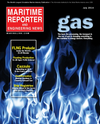
Page 31: of Maritime Reporter Magazine (July 2014)
Offshore Energy Structures & Systems
Read this page in Pdf, Flash or Html5 edition of July 2014 Maritime Reporter Magazine
www.marinelink.com 31
A New Dawn in the Age of Maritime & EnergyMaritime & Energ
By Patricia Keefe
L onger than four football fi elds, as big as six Nimitz-class aircraft car- riers and almost as tall as the Taipei 101 skyscraper, Royal Dutch Shell
PLC is hoping that its record-set- ting, game-changing fl oating liquid natural gas (FLNG) facility will serve as a prelude to a killing in the offshore LNG market.
It’s not alone. Many industry observers believe FLNG will do for gas offshore what fracking has done for shale or natural gas trapped in the ground on shore. “This is revolutionary technology …[that]… has the po- tential to change the way we produce natural gas,” said Neil
Gilmour, Vice President of Development-Integrated Gas,
Shell International. While LNG has been around since the early 60s, Shell’s concept will take it a step further by tak- ing the gas out of the pipes and moving the LNG processing out to sea.
Aptly named Prelude, at 488 meters long, 74 meters wide, and clocking in at 600,000 tonnes when fully ballasted, the FLNG facility, which is under construction at the Sam- sung Heavy Industries shipyard in South Korea, will be the largest object ever fl oated on the ocean. Designed to last 50 years, withstand level 5 cyclone winds and liquefy gas to minus 162 degrees Celsius, the estimated $13 billion “shipzilla” will enable Shell to produce, liquefy, store, and offl oad natural gas from a single vessel. The cost-saving and environmental implications are almost as staggering as the facility itself.
It is scheduled to go into service in 2017, spending the next 25 years tapping the Prelude and Concerto gas fi elds in the Caswell sub-basin of the northern Browse Basin, about 200 kilometers off the coast of Broome, Western Australia.
Once in place, it is expected to produce 3.6 MMt/a of LNG, 0.4 MMt/a of LPG and 1.3 MMt/a of gas condensate an- nually, enough gas to fuel Hong Kong for a year. Once it drains those fi elds, it will head to dry dock for repairs and updates before moving on, likely to the Concerto, Crux and
Libra fi elds. “You have to have the idea, you have to have the engineering solution and you have to have the guts to put it into reality”
Matthias Bichsel, Royal Dutch Shell’s director of projects and technology, to the Wall Street Journal (Photo: Cour tesy Royal Dutch Shell)
The 488 meter long hull of Shell’s Prelude
FLNG plant fl oating out of the dry dock at the Samsung Heavy Industries (SHI) yard in
Geoje, South Korea, Nov. 30, 2013.
MR #7 (26-31).indd 31 7/1/2014 9:05:56 AM

 30
30

 32
32
